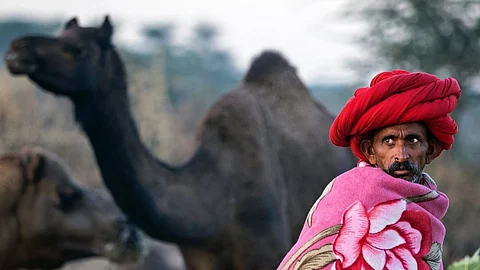
- Destinations
- Experiences
- Stay
- What's new
- Celebrating People
- Responsible Tourism
- CampaignsCampaigns
- SubscribeSubscribe
- Buy Now

Rajasthan’s Pushkar Fair is an annual livestock and cultural event that attracts nearly 600,000 people every year. The five-day affair claims to be the world’s largest camel fair and among the world’s top cattle fairs when it is held in Pushkar, a temple town near Ajmer.
In fact, the camel is the state animal of Rajasthan, part of the region’s cultural identity and an economically important animal for desert communities. The dromedary camel has been an important mode of transportation in the arid and harsh desert environment since ancient times. Camel caravans, also known as kafilas, were the lifeline of the region, facilitating trade routes and connecting various cities. These caravans were responsible for carrying goods such as spices, silk and precious stones from Rajasthan to other parts of India and even to distant lands like Persia and Arabia.
The animals also play a crucial role in agriculture. Due to their ability to survive in harsh desert conditions, they were used for plowing fields and transporting agricultural produce, and were especially valuable during the dry season when access to water and other resources was limited.
Rajasthan is home to 86 per cent of India’s camels, which are herded by the Raika community, an indigenous pastoral tribe that has reared the animal for generations. The community attributes their lifestyle to divine origin, believing they were created by the Hindu deity Shiva to attend to camels.
But the Raika are not just herders; their centuries-old knowledge of pastoral techniques, vital to Rajasthan's ecological health, is in danger of being lost to time.
Hailing from the Sadri village in Rajasthan’s Pali district, the Raika people have been the primary breeders and caretakers of Rajasthan’s indigenous camel breeds, especially the hardy Marwari camel, which is known for its strength, endurance and adaptability to desert climates.
This camel-herding community has followed age-old migratory routes, allowing camels to graze across vast swathes of common land, feeding on desert shrubs and medicinal plants, which also contributed to the animals’ robustness.
When herders, sporting distinctive red turbans and white attire, would take their flocks on a long trek, they often had to cross farmlands. Here, the pastoralists gave the farmer premium fertiliser and fresh milk from the camel. The farmer, in turn, would provide the pastoralist with food. Since the herder’s route seldom changed, an association was formed between the two, which could span generations. This mutually beneficial relationship has dwindled, as many farmers today don’t allow herders on their lands fearing they will destroy the fields or the camels will eat their crops.
How do you know you're looking at a Raika-herded camel? Try to spot a distinct design that is sheared on the camels' sides, a feat made possible because of the deep trust between a herder and their animal. The tribe can communicate with their camels with the slightest tilt of the head or hand, thereby avoiding inflicting cuts. The shorn camel hair is used to make carpets, with the added benefit that shearing also keeps the animal cool.
In earlier times, the Raika would sell young camels to sustain their livelihood. But the advent of modern transportation, laws that curtail their migratory routes and a ban on the sale of camel meat have all contributed to a decline in camel numbers and age-old customs.
In 2016, the Food Safety and Standards Authority of India approved the sale and trade of camel milk as a food item with specific standards in 2016. Today, there’s an industry around camel milk powder, chocolates, soaps and skincare products made from camel milk, but the fledgling market cannot be relied upon as a sustainable source of income.
Furthermore, new laws and policies have curtailed the movement and altered the lifestyle of the Raikas. National parks like Kumbhalgarh in Rajsamand district now restrict access to pastoralists, limiting their centuries-old migration patterns.
This makes it difficult for camel herders to access land and resources. Now, some Raikas have been forced to sell female camels at the Pushkar Fair, something they had never done before 2000, when they only sold male camels.
According to the 20th Indian Livestock Census of 2019, there were some 250,000 camels, down from the 400,000 counted during the previous census in 2012. Rajasthan had 213,000 of them, the lowest in seven decades in the state.
When the Raikas asked the government to ban female slaughter to try to preserve the species, the state government instituted a blanket ban on the slaughter of both male and female camels in 2015, thereby eliminating a steady source of income for the nomadic community. Many Raikas are now working as labourers to support themselves.
While things look bleak, members of the Raika community continue to be deeply tied to their animals. All they hope for is the institutional and societal support to continue practising their indigenous lifestyle for centuries more.
